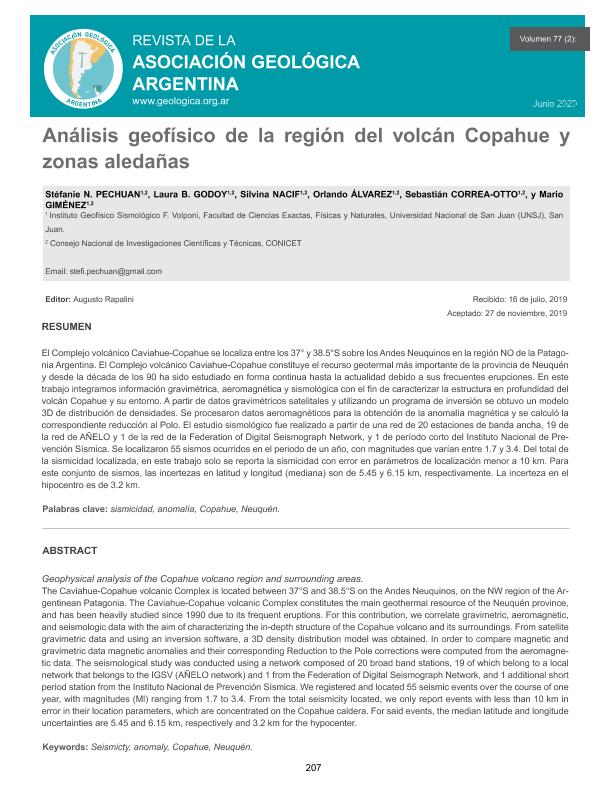Artículo
El Complejo volcánico Caviahue-Copahue se localiza entre los 37° y 38.5°S sobre los Andes Neuquinos en la región NO de la Patagonia Argentina. El Complejo volcánico Caviahue-Copahue constituye el recurso geotermal más importante de la provincia de Neuquén y desde la década de los 90 ha sido estudiado en forma continua hasta la actualidad debido a sus frecuentes erupciones. En este trabajo integramos información gravimétrica, aeromagnética y sismológica con el fin de caracterizar la estructura en profundidad del volcán Copahue y su entorno. A partir de datos gravimétricos satelitales y utilizando un programa de inversión se obtuvo un modelo 3D de distribución de densidades. Se procesaron datos aeromagnéticos para la obtención de la anomalía magnética y se calculó la correspondiente reducción al Polo. El estudio sismológico fue realizado a partir de una red de 20 estaciones de banda ancha, 19 de la red de AÑELO y 1 de la red de la Federation of Digital Seismograph Network, y 1 de período corto del Instituto Nacional de Prevención Sísmica. Se localizaron 55 sismos ocurridos en el periodo de un año, con magnitudes que varían entre 1.7 y 3.4. Del total de la sismicidad localizada, en este trabajo solo se reporta la sismicidad con error en parámetros de localización menor a 10 km. Para este conjunto de sismos, las incertezas en latitud y longitud (mediana) son de 5.45 y 6.15 km, respectivamente. La incerteza en el hipocentro es de 3.2 km. The Caviahue-Copahue volcanic Complex is located between 37°S and 38.5°S on the Andes Neuquinos, on the NW region of the Argentinean Patagonia. The Caviahue-Copahue volcanic Complex constitutes the main geothermal resource of the Neuquén province, and has been heavily studied since 1990 due to its frequent eruptions. For this contribution, we correlate gravimetric, aeromagnetic, and seismologic data with the aim of characterizing the in-depth structure of the Copahue volcano and its surroundings. From satellite gravimetric data and using an inversion software, a 3D density distribution model was obtained. In order to compare magnetic and gravimetric data magnetic anomalies and their corresponding Reduction to the Pole corrections were computed from the aeromagnetic data. The seismological study was conducted using a network composed of 20 broad band stations, 19 of which belong to a local network that belongs to the IGSV (AÑELO network) and 1 from the Federation of Digital Seismograph Network, and 1 additional short period station from the Instituto Nacional de Prevención Sísmica. We registered and located 55 seismic events over the course of one year, with magnitudes (Ml) ranging from 1.7 to 3.4. From the total seismicity located, we only report events with less than 10 km in error in their location parameters, which are concentrated on the Copahue caldera. For said events, the median latitude and longitude uncertainties are 5.45 and 6.15 km, respectively and 3.2 km for the hypocenter.
Análisis geofísico de la región del volcán Copahue y zonas aledañas
Título:
Geophysical analysis of the Copahue volcano region and surrounding areas
Pechuan Canet, Stefanie Nadia ; Godoy, Laura Beatriz
; Godoy, Laura Beatriz ; Nacif Suvire, Silvina Valeria
; Nacif Suvire, Silvina Valeria ; Alvarez Pontoriero, Orlando
; Alvarez Pontoriero, Orlando ; Correa Otto, Sebastian Ariel
; Correa Otto, Sebastian Ariel ; Gimenez, Mario Ernesto
; Gimenez, Mario Ernesto
 ; Godoy, Laura Beatriz
; Godoy, Laura Beatriz ; Nacif Suvire, Silvina Valeria
; Nacif Suvire, Silvina Valeria ; Alvarez Pontoriero, Orlando
; Alvarez Pontoriero, Orlando ; Correa Otto, Sebastian Ariel
; Correa Otto, Sebastian Ariel ; Gimenez, Mario Ernesto
; Gimenez, Mario Ernesto
Fecha de publicación:
07/2020
Editorial:
Asociación Geológica Argentina
Revista:
Revista de la Asociación Geológica Argentina
ISSN:
0004-4822
e-ISSN:
1851-8249
Idioma:
Español
Tipo de recurso:
Artículo publicado
Clasificación temática:
Resumen
Palabras clave:
Sismicidad
,
Anomalía
,
Copahue
,
Neuquén
Archivos asociados
Licencia
Identificadores
Colecciones
Articulos(CCT - SAN JUAN)
Articulos de CENTRO CIENTIFICO TECNOLOGICO CONICET - SAN JUAN
Articulos de CENTRO CIENTIFICO TECNOLOGICO CONICET - SAN JUAN
Citación
Pechuan Canet, Stefanie Nadia; Godoy, Laura Beatriz; Nacif Suvire, Silvina Valeria; Alvarez Pontoriero, Orlando; Correa Otto, Sebastian Ariel; et al.; Análisis geofísico de la región del volcán Copahue y zonas aledañas; Asociación Geológica Argentina; Revista de la Asociación Geológica Argentina; 77; 2; 7-2020; 207-219
Compartir



